Normally, the hip functions as a "ball-and-socket" joint. The top of the thigh bone, or femur, (ball) fits into a part of the pelvis called the acetabulum (socket), allowing the joint to move smoothly in multiple directions . Total hip replacement is a surgical procedure that replaces the hip joint with artificial parts (called prostheses).
The most common cause of hip joint deterioration is osteoarthritis; other possible causes include inflammatory arthritis (eg, rheumatoid or psoriatic arthritis), hip disorders of infancy and childhood, osteonecrosis (avascular necrosis), and trauma.
Total hip replacement is only considered when you have tried and failed more conservative treatments, yet you continue to have significant pain, stiffness, or problems with the function of your hip.
Total hip replacement may be performed on adults with a deteriorated hip. However, the replacement parts can break down over time, and healthcare providers generally recommend delaying hip replacement until it is absolutely necessary.
While total hip replacement can be helpful under the right circumstances, you should only consider it after a discussion of the risks, benefits, and alternatives with a healthcare provider.
Nonsurgical treatment — Nonsurgical treatment methods are initially recommended for people with hip problems due to osteoarthritis or other conditions. Nonsurgical treatments for people with osteoarthritis include
● Weight loss or maintenance of a healthy weight
● Physical therapy
●Use of an assistive device (such as a cane or walker)
●Pain-relieving medications
●Glucocorticoid (steroid) injection into the painful joint
People with inflammatory arthritis (such as rheumatoid arthritis) may benefit from a treatment regimen of antirheumatic or other medications.
Surgical alternatives — There are few surgical alternatives to total hip replacement once the hip joint has completely deteriorated. Alternative procedures, such as osteotomy (in which the bones are cut and fixed into a new position) or total hip resurfacing (in which only the surface of the joint is replaced), may be considered in people who are very young or in whom a hip replacement may not be durable enough to last for many years and/or may not withstand heavy-impact loading activities. The best surgical procedure depends upon the reasons for which the joint deteriorated.
There is evidence that taking certain steps before hip replacement can improve a person's results while also helping avoid complications related to the surgery [1]. This is sometimes called "preoperative optimization." Key components include quitting smoking (if you smoke), careful diabetes management if you have diabetes, weight loss if needed (typically with a goal body mass index [BMI] of less than 40), obstructive sleep apnea (OSA) screening, deep vein thrombosis (DVT) risk assessment, and addressing any other health conditions you have. There is also evidence that preoperative physical therapy can also improve postoperative results .
Total hip replacement is performed in an operating room after you are given general or regional (epidural or spinal) anesthesia. The surgical approach used will be determined by your surgeon and is typically a single incision along the posterior (rear), lateral (side), or anterior (front) aspect of the hip. Less invasive hip replacement surgery techniques, which use smaller incisions and specialized instruments, are often used.
The type of prosthesis and the material used for the "bearing surface" (outer layer) depends upon the needs of the particular patient and the surgeon performing the procedure. There are a variety of types of prosthetic bearing surfaces, including metal-on-plastic, ceramic-on-plastic, and ceramic-on-ceramic. Each surface has unique advantages and disadvantages, and your surgeon can discuss which is appropriate for you.
Management — After surgery, you will be given pain medication through your intravenous line (IV) or by mouth. You will also be given an antibiotic to prevent infection. Extended antibiotics beyond 24 hours are not typically recommended following routine hip replacement.
Most people are also given a medication to help prevent blood clots in the legs. Compression boots (devices that are worn around the legs and that inflate periodically) are often worn to prevent blood clots. Compression stockings may also be recommended.
Rehabilitation — Physical therapy (PT) is an important part of the recovery process. Most people are able to stand and even walk, with the help of a physical therapist, within the first 24 hours.
Your length of stay in the hospital will depend upon a number of factors, including pain control, demonstration of safe mobility, and medical stability. After your surgery, you will work with a physical therapist to develop an exercise and rehabilitation program. With less invasive surgical techniques and evolving protocols for pain management, an increasing number of hip replacements are being done as "outpatient" procedures, meaning you can go home the same day. In some situations, it isn't safe to go home immediately, and you will need to stay in the hospital or go to a nursing facility for rehabilitation.
You will continue your therapy until you are able to independently perform daily activities. The rehabilitation program generally includes exercises to stretch and strengthen the muscles surrounding the hip joint, as well as training in activities of daily life (eg, stair climbing, bending, walking). The goal of the rehabilitation is to regain strength and motion.
After several weeks of recovery, you will be encouraged to return to an active lifestyle. Most people can resume their normal activities within weeks to months. With newer surgical techniques, recovery time may be reduced. Continued improvement may be seen up to 12 months following surgery. While high-impact sports such as running and contact sports are not usually recommended after hip replacement, you can typically participate in most other low-impact activities like walking, cycling, and swimming.
With modern implants and bearing surfaces, it is now anticipated that most hip replacements will last well beyond the previous expectation of 10 to 15 years. Most people are very satisfied with their outcome, reporting minimal to no pain and significantly improved function and quality of life.
Serious complications after hip replacement surgery are not common and can be minimized by choosing a surgeon who is experienced and performs the procedure frequently. In addition, choosing a hospital that specializes in caring for joint replacement patients before, during, and after surgery can also minimize complications.
Complications can occur during surgery, in the immediate postoperative period, or many years after surgery. It is important to understand these potential risks before deciding to undergo hip replacement. For most people, the benefits of reduced pain and improved function outweigh the small risk of complications.
The following are some of the complications that can occur during or after hip replacement surgery.
Complications during surgery — Very rarely, complications can occur during the actual hip replacement procedure. These include fractures (typically of the femur) and injury to the surrounding nerves or blood vessels. Most of these complications can be treated during the course of the surgery.
Blood clots — People who undergo hip replacement are at increased risk for developing blood clots after surgery. With appropriate preventive treatments, only about 1 percent of people will develop a blood clot in the leg (deep vein thrombosis) or lungs (pulmonary embolism).
Infection — Infection following hip replacement is uncommon (between 0.4 and 1.5 percent of cases). Prevention protocols that include preoperative weight loss, smoking cessation, methicillin-resistant Staphylococcus aureus (MRSA) screening, skin preparation/washing, and routine antibiotics (during the first 24 hours only) can all help to minimize the risk of infection.
Dislocation — Dislocation of the artificial hip joint can occur if the ball becomes dislodged from the socket. Dislocation occurs in less than 2 percent of cases. In most cases, the joint can be put back into place by a doctor while the person is sedated.
To minimize the risk of dislocation, some people may be given specific precautions related to the motion of the hip. The need for precautions depends upon how your surgery is performed and should be discussed with your surgeon.
Loosening — Loosening of the joint implant is most often caused by wear of the prosthetic components. It is the most common long-term problem associated with total hip replacement, although the number of people who develop loosening is decreasing as prosthetic materials and surfaces are improved.
Breakage — Breakage of the implant itself can occur as a result of wear and tear of the prosthesis, often over the course of years. Older implants are more likely to break, while newer prostheses are stronger and more durable. This is a rare occurrence, with less than 0.5 percent of people experiencing breakage.
Change in leg length — Before, during, and after hip replacement surgery, a surgeon carefully measures the length of your legs in an attempt to make them equal length. However, in rare cases, the procedure results in one leg being slightly longer than the other. Some people with a significant difference in leg length find that wearing a lift in one shoe is helpful.
Joint stiffening — Joint stiffening caused by extra bone formation, also called heterotopic ossification, is a process in which some soft tissues around the hip harden into bone. People with this problem may experience hip stiffness or may feel no discomfort at all. If you are at risk for joint stiffening, your healthcare provider may recommend a preventive treatment.

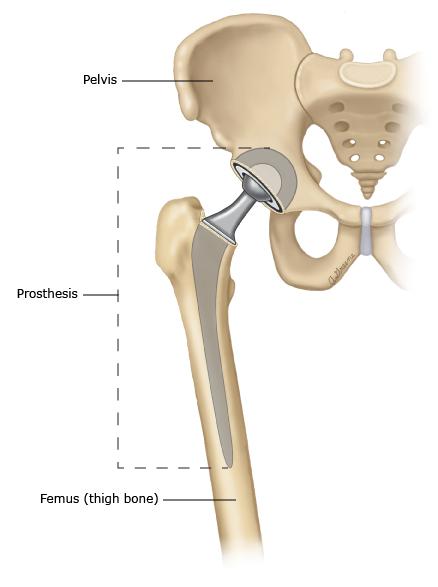
If your knee is severely damaged by arthritis or injury, it may be hard for you to perform simple activities, such as walking or climbing stairs. You may even begin to feel pain while you are sitting or lying down.
If nonsurgical treatments like medications and using walking supports are no longer helpful, you may want to consider total knee replacement surgery. Joint replacement surgery is a safe and effective procedure to relieve pain, correct leg deformity, and help you resume normal activities.
Knee replacement surgery was first performed in 1968. Since then, improvements in surgical materials and techniques have greatly increased its effectiveness. Total knee replacements are one of the most successful procedures in all of medicine. According to the Agency for Healthcare Research and Quality, in 2017, more than 754,000 knee replacements were performed in the United States.
Whether you have just begun exploring treatment options or have already decided to have total knee replacement surgery, this article will help you understand more about this valuable procedure.
The knee is the largest joint in the body and having healthy knees is required to perform most everyday activities.
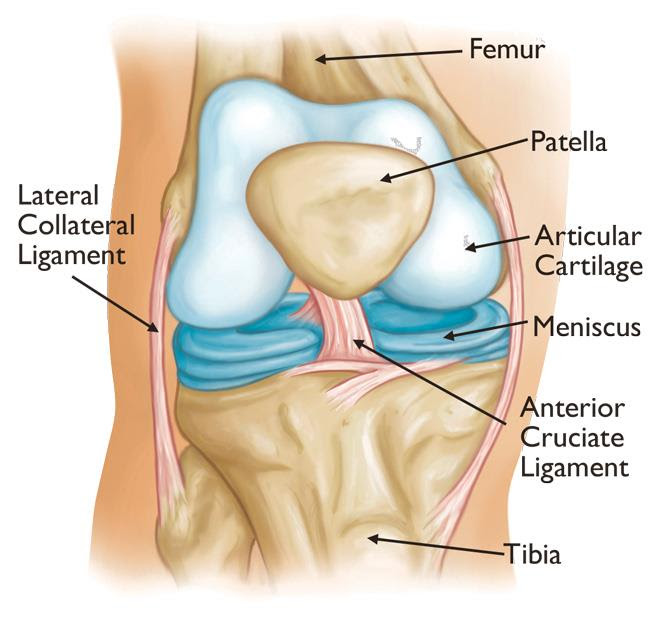
Normal knee anatomy. In a healthy knee, these structures work together to ensure smooth, natural function and movement.
The knee is made up of the lower end of the thighbone (femur), the upper end of the shinbone (tibia), and the kneecap (patella). The ends of these three bones are covered with articular cartilage, a smooth substance that protects the bones and enables them to move easily within the joint.
The menisci are located between the femur and tibia. These C-shaped wedges act as shock absorbers that cushion the joint.
Large ligaments hold the femur and tibia together and provide stability. The long thigh muscles give the knee strength.
All remaining surfaces of the knee are covered by a thin lining called the synovial membrane. This membrane releases a fluid that lubricates the cartilage, reducing friction to nearly zero in a healthy knee.
Normally, all of these components work in harmony. But disease or injury can disrupt this harmony, resulting in pain, muscle weakness, and reduced function.
The most common cause of chronic knee pain and disability is arthritis. Although there are many types of arthritis, most knee pain is caused by just three types: osteoarthritis, rheumatoid arthritis, and posttraumatic arthritis.
● Osteoarthritis. This is an age-related wear and tear type of arthritis. It usually occurs in people 50 years of age and older, but may occur in younger people, too. The cartilage that cushions the bones of the knee softens and wears away. The bones then rub against one another, causing knee pain and stiffness.
Osteoarthritis often results in bone rubbing on bone. Bone spurs are a common feature of this form of arthritis.
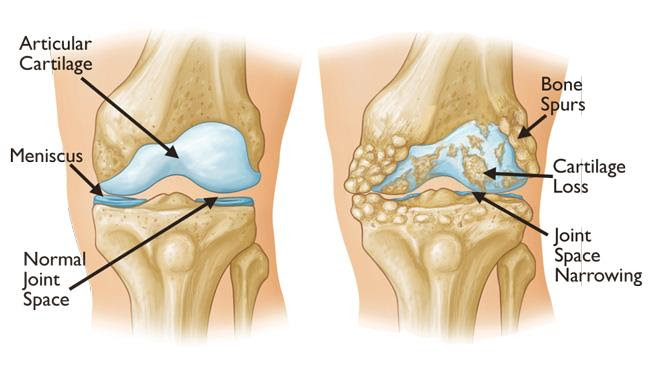
● Rheumatoid arthritis. This is a disease in which the synovial membrane that surrounds the joint becomes inflamed and thickened. This chronic inflammation can damage the cartilage and eventually cause cartilage loss, pain, and stiffness. Rheumatoid arthritis is the most common form of a group of disorders termed "inflammatory arthritis."
● Posttraumatic arthritis. This can follow a serious knee injury. Fractures of the bones surrounding the knee or tears of the knee ligaments may damage the articular cartilage over time, causing knee pain and limiting knee function.
A knee replacement (also called knee arthroplasty) might be more accurately termed a knee "resurfacing" because only the surface of the bones are replaced.
There are four basic steps to a knee replacement procedure:
● Prepare the bone. The damaged cartilage surfaces at the ends of the femur and tibia are removed along with a small amount of underlying bone.
● Position the metal implants. The removed cartilage and bone is replaced with metal components that recreate the surface of the joint. These metal parts may be cemented or "press-fit" into the bone.
● Resurface the patella. The undersurface of the patella (kneecap) is cut and resurfaced with a plastic button. Some surgeons do not resurface the patella, depending upon the case.
● Insert a spacer. A medical-grade plastic spacer is inserted between the metal components to create a smooth gliding surface.
(Left) Severe osteoarthritis. (Right) The arthritic cartilage and underlying bone has been removed and resurfaced with metal implants on the femur and tibia. A plastic spacer has been placed in between the implants. The patellar component is not shown for clarity.
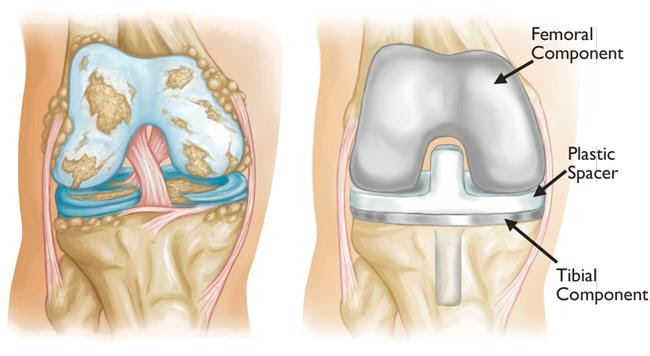
The decision to have total knee replacement surgery should be a cooperative one between you, your family, your primary care doctor, and your orthopaedic surgeon. Your doctor may refer you to an orthopaedic surgeon for a thorough evaluation to determine if you might benefit from this surgery.
There are several reasons why your doctor may recommend knee replacement surgery. People who benefit from total knee replacement often have:
● Severe knee pain or stiffness that limits everyday activities, including walking, climbing stairs, and getting in and out of chairs. It may be hard to walk more than a few blocks without significant pain and it may be necessary to use a cane or walker
● Moderate or severe knee pain while resting, either day or night
● Chronic knee inflammation and swelling that does not improve with rest or medications
● Knee deformity — a bowing in or out of the knee
● Failure to substantially improve with other treatments such as anti-inflammatory medications, cortisone injections, lubricating injections, physical therapy, or other surgeries
Total knee replacement may be recommended for patients with bowed knee deformity, like that shown in this clinical photo.
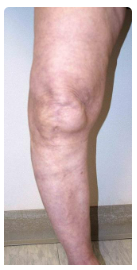
There are no absolute age or weight restrictions for total knee replacement surgery.
Recommendations for surgery are based on a patient's pain and disability, not age. Most patients who undergo total knee replacement are aged 50 to 80, but orthopaedic surgeons evaluate patients individually. Total knee replacements have been performed successfully at all ages, from the young teenager with juvenile arthritis to the elderly patient with degenerative arthritis.
An evaluation with an orthopaedic surgeon consists of several components:
● Medical history. Your orthopaedic surgeon will gather information about your general health and ask you about the extent of your knee pain and your ability to function.
● Physical examination. This will assess knee motion, stability, strength, and overall leg alignment.
● X-rays. These images help to determine the extent of damage and deformity in your knee.
● Other tests. Occasionally blood tests or advanced imaging, such as a magnetic resonance imaging (MRI) scan, may be needed to determine the condition of the bone and soft tissues of your knee.
(Left) In this X-ray of a normal knee, the space between the bones indicates healthy cartilage (arrows). (Right) This X-ray of a knee that has become bowed from arthritis shows severe loss of joint space (arrows).
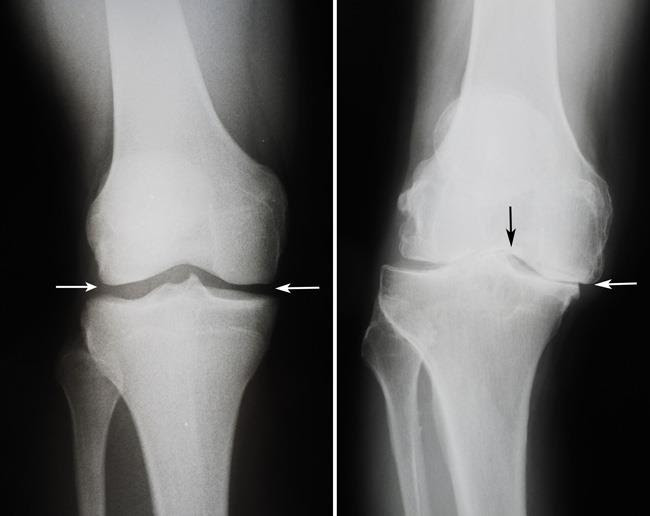
Your orthopaedic surgeon will review the results of your evaluation with you and discuss whether total knee replacement is the best method to relieve your pain and improve your function. Other treatment options — including medications, injections, physical therapy, or other types of surgery — will also be considered and discussed.
In addition, your orthopaedic surgeon will explain the potential risks and complications of total knee replacement, including those related to the surgery itself and those that can occur over time after your surgery.
An important factor in deciding whether to have total knee replacement surgery is understanding what the procedure can and cannot do.
Most people who have total knee replacement surgery experience a dramatic reduction of knee pain and a significant improvement in the ability to perform common activities of daily living. But total knee replacement will not allow you to do more than you could before you developed arthritis.
With normal use and activity, every knee replacement implant begins to wear in its plastic spacer. Excessive activity or weight may speed up this normal wear and may cause the knee replacement to loosen and become painful. Therefore, most surgeons advise against high-impact activities such as running, jogging, jumping, or other high-impact sports for the rest of your life after surgery.
Realistic activities following total knee replacement include unlimited walking, swimming, golf, driving, light hiking, biking, ballroom dancing, and other low-impact sports.
With appropriate activity modification, knee replacements can last for many years.
The complication rate following total knee replacement is low. Serious complications, such as a knee joint infection, occur in fewer than 2% of patients. Major medical complications such as heart attack or stroke occur even less frequently. Chronic illnesses may increase the potential for complications. Although uncommon, when these complications occur, they can prolong or limit full recovery.
Discuss your concerns thoroughly with your orthopaedic surgeon prior to surgery.
Infection. Infection may occur in the wound or deep around the prosthesis. It may happen within days or weeks of your surgery. It may even occur years later. Minor infections in the wound area are generally treated with antibiotics. Major or deep infections may require more surgery and removal of the prosthesis. Any infection in your body can spread to your joint replacement.
Blood clots. Blood clots in the leg veins are one of the most common complications of knee replacement surgery. These clots can be life-threatening if they break free and travel to your lungs. Your orthopaedic surgeon will outline a prevention program, which may include periodic elevation of your legs, lower leg exercises to increase circulation, support stockings, and medication to thin your blood.
Blood clots may form in one of the deep veins of the body.
While blood clots can occur in any deep vein, they most commonly form in the veins of the pelvis, calf, or thigh.

Implant problems. Although implant designs and materials, as well as surgical techniques, continue to advance, implant surfaces may wear down and the components may loosen. Additionally, although an average of 115° of motion is generally anticipated after surgery, scarring of the knee can occasionally occur, and motion may be more limited, particularly in patients with limited motion before surgery.
Continued pain. A small number of patients continue to have pain after a knee replacement. This complication is rare, however, and most patients experience excellent pain relief following knee replacement.
Neurovascular injury. While rare, injury to the nerves or blood vessels around the knee can occur during surgery.
If you decide to have total knee replacement surgery, your orthopaedic surgeon may ask you to schedule a complete physical examination with your doctor several weeks before the operation. This is needed to make sure you are healthy enough to have the surgery and complete the recovery process. Many patients with chronic medical conditions, like heart disease, may also be evaluated by a specialist, such as a cardiologist, before the surgery.
Several tests, such as blood and urine samples, and an electrocardiogram, may be needed to help your orthopaedic surgeon plan your surgery.
Tell your orthopaedic surgeon about the medications you are taking. He or she will tell you which medications you should stop taking and which you should continue to take before surgery.
Although the incidence of infection after knee replacement is very low, an infection can occur if bacteria enter your bloodstream. To reduce the risk of infection, major dental procedures (such as tooth extractions and periodontal work) should be completed before your total knee replacement surgery.
People with a history of recent or frequent urinary infections should have a urological evaluation before surgery. Older men with prostate disease should consider completing required treatment before undertaking knee replacement surgery.
Although you will be able to walk with a cane, crutches, or a walker soon after surgery, you will need help for several weeks with such tasks as cooking, shopping, bathing, and doing laundry.
If you live alone, a social worker or a discharge planner at the hospital can help you make advance arrangements to have someone assist you at home. They also can help you arrange for a short stay in an extended care facility during your recovery if this option works best for you.
Several modifications can make your home easier to navigate during your recovery. The following items may help with daily activities:
● Safety bars or a secure handrail in your shower or bath
● Secure handrails along your stairways
● A stable chair for your early recovery with a firm seat cushion (and a height of 18 to 20 inches), a firm back, two arms, and a footstool for intermittent leg elevation
● A toilet seat riser with arms, if you have a low toilet
● A stable shower bench or chair for bathing
● Removing all loose carpets and cords
● A temporary living space on the same floor because walking up or down stairs will be more difficult during your early recovery
You will either be admitted to the hospital on the day of your surgery, or you will go home the same day. The plan to either be admitted or to go home should be discussed with your surgeon prior to your operation.
Upon arrival at the hospital or surgery center, you will be evaluated by a member of the anesthesia team. The most common types of anesthesia are general anesthesia (you are put to sleep) or spinal, epidural, or regional nerve block anesthesia (you are awake but your body is numb from the waist down). The anesthesia team, with your input, will determine which type of anesthesia will be best for you.
The surgical procedure usually takes from 1 to 2 hours. Your orthopaedic surgeon will remove the damaged cartilage and bone, and then position the new metal and plastic implants to restore the alignment and function of your knee.
Different types of knee implants are used to meet each patient's individual needs.
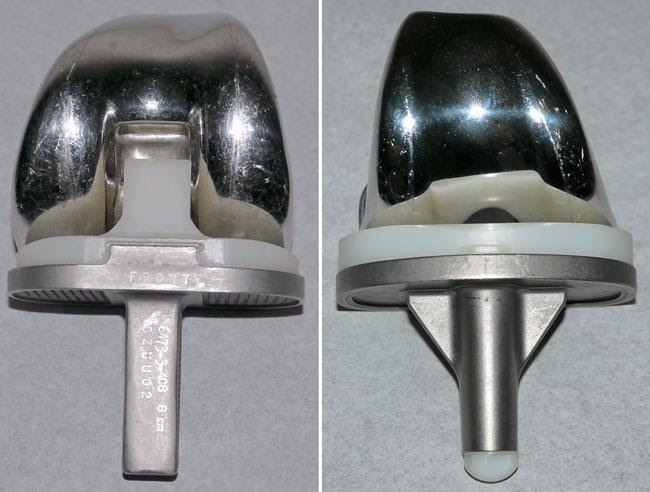

(Left) An X-ray of a severely arthritic knee. (Right) The X-ray appearance of a total knee replacement. Note that the plastic spacer inserted between the components does not show up in an X-ray.
After surgery, you will be moved to the recovery room, where you will remain for several hours while your recovery from anesthesia is monitored. After you wake up, you will be taken to your hospital room or discharged to home.
If you are admitted to the hospital, you will most likely stay from one to three days.
After surgery, you will feel some pain. This is a natural part of the healing process. Your doctor and nurses will work to reduce your pain, which can help you recover from surgery faster.
Medications are often prescribed for short-term pain relief after surgery. Many types of medicines are available to help manage pain, including opioids, nonsteroidal anti-inflammatory drugs (NSAIDs), acetaminophen, and local anesthetics. Your doctor may use a combination of these medications to improve pain relief, as well as minimize the need for opioids.
Be aware that although opioids help relieve pain after surgery, they are a narcotic and can be addictive. Opioid dependency and overdose have become critical public health issues in the U.S. It is important to use opioids only as directed by your doctor. As soon as your pain begins to improve, stop taking opioids. Talk to your doctor if your pain has not begun to improve within a few days of your surgery.
Your orthopaedic surgeon may prescribe one or more measures to prevent blood clots and decrease leg swelling. These may include special support hose, inflatable leg coverings (compression boots), and blood thinners.
Foot and ankle movement is also encouraged immediately following surgery to increase blood flow in your leg muscles to help prevent leg swelling and blood clots.
Most patients can begin exercising their knee hours after surgery. A physical therapist will teach you specific exercises to strengthen your leg and restore knee movement to allow walking and other normal daily activities soon after your surgery.
To restore movement in your knee and leg, your surgeon may use a knee support that slowly moves your knee while you are in bed. The device is called a continuous passive motion (CPM) exercise machine. Some surgeons believe that a CPM machine decreases leg swelling by elevating your leg and improves your blood circulation by moving the muscles of your leg, but there is no evidence that these machines improve outcomes.
A continuous passive motion (CPM) machine.
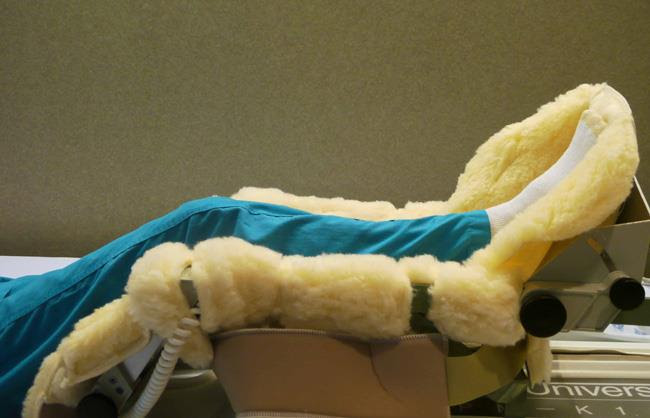
It is common for patients to have shallow breathing in the early postoperative period. This is usually due to the effects of anesthesia, pain medications, and increased time spent in bed. This shallow breathing can lead to a partial collapse of the lungs (termed "atelectasis"), which can make patients susceptible to pneumonia. To help prevent this, it is important to take frequent deep breaths. Your nurse may provide a simple breathing apparatus called a spirometer to encourage you to take deep breaths.
The success of your surgery will depend largely on how well you follow your orthopaedic surgeon's instructions at home during the first few weeks after surgery.
You will have stitches or staples running along your wound or a suture beneath your skin on the front of your knee. The stitches or staples will be removed several weeks after surgery. A suture beneath your skin will not require removal.
Avoid soaking the wound in water until it has thoroughly sealed and dried. You may continue to bandage the wound to prevent irritation from clothing or support stockings.
Some loss of appetite is common for several weeks after surgery. A balanced diet, often with an iron supplement, is important to help your wound heal and to restore muscle strength.
Exercise is a critical component of home care, particularly during the first few weeks after surgery. You should be able to resume most normal activities of daily living within 3 to 6 weeks following surgery. Some pain with activity and at night is common for several weeks after surgery.
Your activity program should include:
● A graduated walking program — initially in your home and later outside — to slowly increase your mobility
● Resuming other normal household activities, such as sitting, standing, and climbing stairs
● Specific exercises several times a day to restore movement and strengthen your knee. You probably will be able to perform the exercises without help, but you may have a physical therapist help you at home or in a therapy center the first few weeks after surgery.
Physical therapy will help restore movement and function.
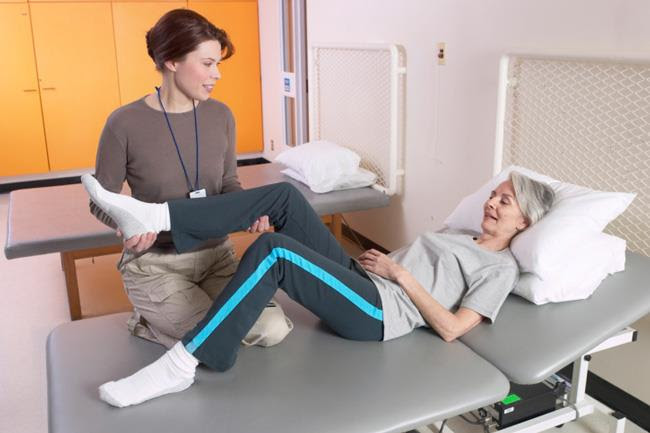
You will most likely be able to resume driving when your knee bends enough that you can enter and sit comfortably in your car, and when your muscle control provides adequate reaction time for braking and acceleration. Most people resume driving approximately 4 to 6 weeks after surgery.
Follow your orthopaedic surgeon's instructions carefully to reduce the risk of blood clots developing during the first several weeks of your recovery. They may recommend that you continue taking the blood thinning medication you started in the hospital. Notify your doctor immediately if you develop any of the following warning signs.
Warning signs of blood clots. The warning signs of possible blood clots in your leg include:
● Increasing pain in your calf
● Tenderness or redness above or below your knee
● New or increasing swelling in your calf, ankle, and foot
Warning signs of pulmonary embolism.The warning signs that a blood clot has traveled to your lung include:
● Sudden shortness of breath
● Sudden onset of chest pain
● Localized chest pain with coughing
A common cause of infection following total knee replacement surgery is from bacteria that enter the bloodstream during dental procedures, urinary tract infections, or skin infections. These bacteria can lodge around your knee replacement and cause an infection.
After knee replacement, patients with certain risk factors may need to take antibiotics prior to dental work, including dental cleanings, or before any surgical procedure that could allow bacteria to enter the bloodstream. Your orthopaedic surgeon will discuss with you whether you need to take preventive antibiotics before dental procedures.
Warning signs of infection. Notify your doctor immediately if you develop any of the following signs of a possible knee replacement infection:
● Persistent fever (higher than 100°F orally)
● Chills
● Increasing redness, tenderness, or swelling of the knee wound
● Drainage from the knee wound
● Increasing knee pain with both activity and rest
A fall during the first few weeks after surgery can damage your new knee and may result in a need for further surgery. Stairs are a particular hazard until your knee is strong and mobile. You should use a cane, crutches, a walker, or handrails, or have someone to help you until you have improved your balance, flexibility, and strength.
Your surgeon and physical therapist will help you decide what assistive aides will be required following surgery and when those aides can safely be discontinued.
Improvement of knee motion is a goal of total knee replacement, but restoration of full motion is uncommon. The motion of your knee replacement after surgery can be predicted by the range of motion you have in your knee before surgery. Most patients can expect to be able to almost fully straighten the replaced knee and to bend the knee sufficiently to climb stairs and get in and out of a car. Kneeling is sometimes uncomfortable, but it is not harmful.
Most people feel some numbness in the skin around their incisions. You also may feel some stiffness, particularly with excessive bending activities.
Most people also feel or hear some clicking of the metal and plastic with knee bending or walking. This is normal. These differences often diminish with time and most patients find them to be tolerable when compared with the pain and limited function they experienced prior to surgery.
Your new knee may activate metal detectors required for security in airports and some buildings. Tell the security agent about your knee replacement if the alarm is activated.
After surgery, make sure you also do the following:
● Participate in regular light exercise programs to maintain proper strength and mobility of your new knee.
● Take special precautions to avoid falls and injuries. If you break a bone in your leg, you may require more surgery.
● Let your dentist know that you have a knee replacement. Talk with your orthopaedic surgeon about whether you need to take antibiotics prior to dental procedures.
● See your orthopaedic surgeon periodically for routine follow-up examinations and X-rays. Your surgeon will talk with you about the frequency and timing of these visits.
Currently, more than 90% of modern total knee replacements are still functioning well 15 years after the surgery. Following your orthopaedic surgeon's instructions after surgery and taking care to protect your knee replacement and your general health are important ways you can contribute to the final success of your surgery.
Although shoulder joint replacement is less common than knee or hip replacement, it is just as successful in relieving joint pain.
Shoulder replacement surgery was first performed in the United States in the 1950s to treat severe shoulder fractures. Over the years, shoulder joint replacement has come to be used for many other painful conditions of the shoulder, such as different forms of arthritis.
Today, about 53,000 people in the U.S. have shoulder replacement surgery each year, according to the Agency for Healthcare Research and Quality. This compares to more than 900,000 Americans a year who have knee and hip replacement surgery.
If nonsurgical treatments like medications and activity changes are no longer helpful for relieving pain, you may want to consider shoulder joint replacement surgery. Joint replacement surgery is a safe and effective procedure to relieve pain and help you resume everyday activities.
Whether you have just begun exploring treatment options or have already decided to have shoulder joint replacement surgery, this article will help you understand more about this valuable procedure.
Your shoulder is made up of three bones: your upper arm bone (humerus), your shoulder blade (scapula), and your collarbone (clavicle). The shoulder is a ball-and-socket joint: The ball, or head, of your upper arm bone fits into a shallow socket in your shoulder blade. This socket is called the glenoid.
The bones of a healthy shoulder joint.
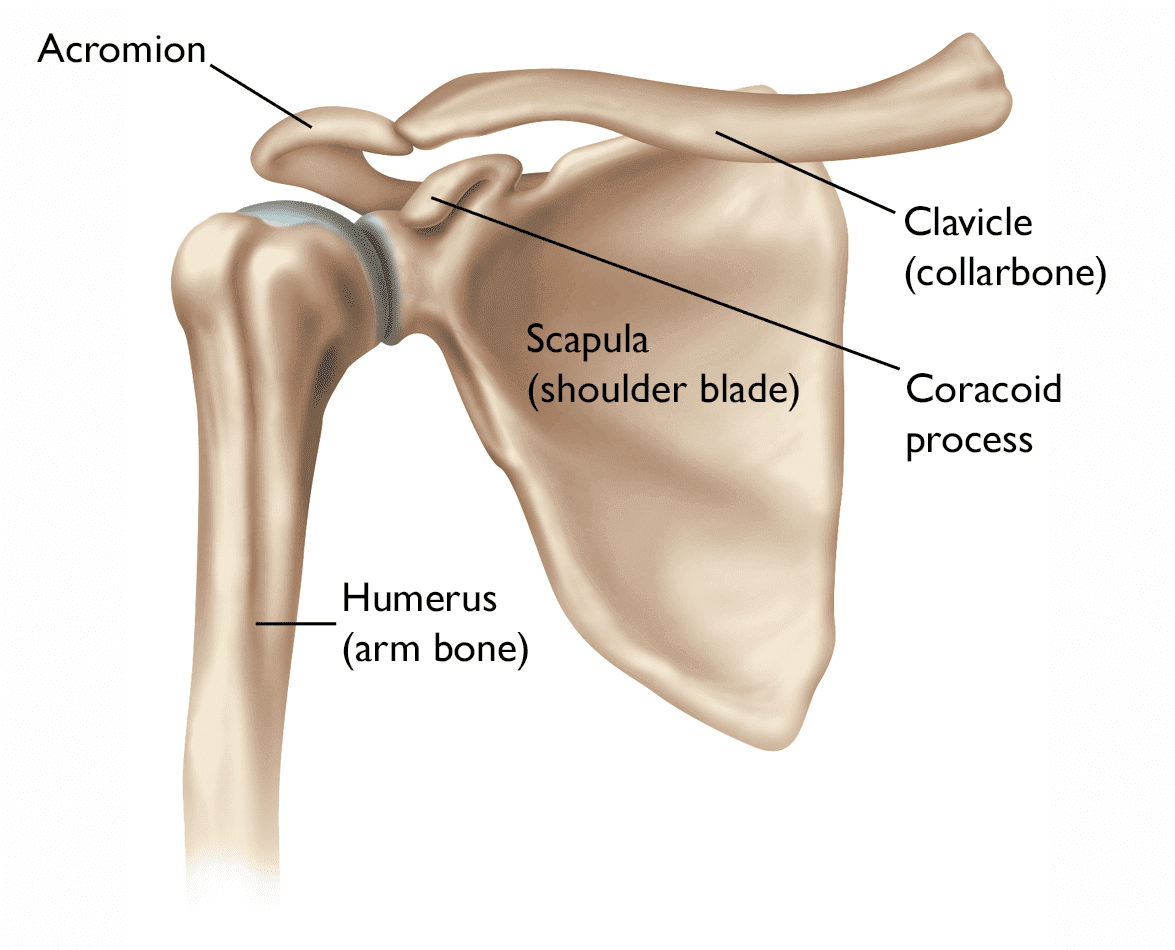
The surfaces of the bones where they touch are covered with articular cartilage, a smooth substance that protects the bones and enables them to move easily. A thin, smooth tissue called synovial membrane covers all remaining surfaces inside the shoulder joint. In a healthy shoulder, this membrane makes a small amount of fluid that lubricates the cartilage and eliminates almost any friction in your shoulder.
The muscles and tendons that surround the shoulder provide stability and support.
All of these structures allow the shoulder to rotate through a greater range of motion than any other joint in the body.
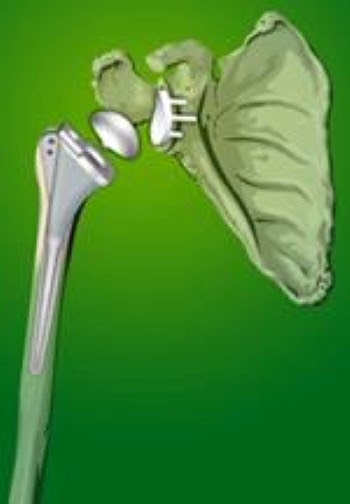
In shoulder replacement surgery, the damaged parts of the shoulder are removed and replaced with artificial components, called a prosthesis. The treatment options are either replacement of just the head of the humerus bone (ball), or replacement of both the ball and the socket (glenoid). Cause
The treatment options are either replacement of just the head of the humerus bone (ball), or replacement of both the ball and the socket (glenoid).
Several conditions can cause shoulder pain and disability, and lead patients to consider shoulder joint replacement surgery. Osteoarthritis (Degenerative Joint Disease)
Osteoarthritis is an age-related wear-and-tear type of arthritis. It usually occurs in people 50 years of age and older, but may occur in younger people, too. The cartilage that cushions the bones of the shoulder softens and wears away. The bones then rub against one another. Over time, the shoulder joint slowly becomes stiff and painful.
Unfortunately, there is no way to prevent the development of osteoarthritis. It is a common reason people have shoulder replacement surgery.
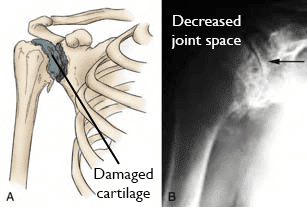
Osteoarthritis of the shoulder. As the cartilage that covers the ends of the bones wears away, it can result in bone rubbing on bone and produce painful bone spurs.
This is a disease in which the synovial membrane that surrounds the joint becomes inflamed and thickened. This chronic inflammation can damage the cartilage and eventually cause cartilage loss, pain, and stiffness. Rheumatoid arthritis is the most common form of a group of disorders termed inflammatory arthritis.
This can follow a serious shoulder injury. Fractures of the bones that make up the shoulder or tears of the shoulder tendons or ligaments may damage the articular cartilage over time. This causes shoulder pain and limits shoulder function.
A patient with a very large, long-standing rotator cuff tear may develop cuff tear arthropathy. In this condition, the changes in the shoulder joint due to the rotator cuff tear may lead to arthritis and destruction of the joint cartilage.
Avascular necrosis, or osteonecrosis, is a painful condition that occurs when the blood supply to the bone is disrupted. Because bone cells die without a blood supply, osteonecrosis can ultimately cause destruction of the shoulder joint and lead to arthritis. Chronic steroid use, deep sea diving, severe fracture of the shoulder, sickle cell disease, and heavy alcohol use are all risk factors for avascular necrosis.
A severe fracture of the shoulder is another common reason people have shoulder replacements. When the head of the upper arm bone is shattered, it may be very difficult for a doctor to put the pieces of bone back in place. In addition, the blood supply to the bone pieces can be interrupted. In this case, a surgeon may recommend a shoulder replacement. Older patients with osteoporosis are most at risk for severe shoulder fractures.
Although uncommon, some shoulder replacements fail, most often because of implant loosening, wear, infection, and dislocation. When this occurs, a second joint replacement surgery — called a revision surgery — may be necessary.
The decision to have shoulder replacement surgery should be a cooperative one between you, your family, your family physician, and your orthopaedic surgeon.
There are several reasons why your doctor may recommend shoulder replacement surgery. People who benefit from surgery often have:
● Severe shoulder pain that interferes with everyday activities, such as reaching into a cabinet, dressing, toileting, and washing.
● Moderate to severe pain while resting. This pain may be severe enough to prevent a good night's sleep.
● Loss of motion and/or weakness in the shoulder.
● Failure to substantially improve with other treatments such as anti-inflammatory medications, cortisone injections, and/or physical therapy.
Your family physician may refer you to an orthopaedic surgeon for a thorough evaluation to determine if you can benefit from this surgery.
An evaluation with an orthopaedic surgeon consists of several components:
● A medical history. Your orthopaedic surgeon will gather information about your general health and ask you about the extent of your shoulder pain and your ability to function.
● A physical examination.This will assess shoulder motion, stability, and strength.
● X-rays.X-rays help to determine the extent of damage in your shoulder. They can show loss of the normal joint space between bones, flattening or irregularity in the shape of the bone, bone spurs, and loose pieces of cartilage or bone that may be floating inside the joint.
● Other tests.Occasionally, your doctor may order blood tests, a computed tomography (CT) scan, a magnetic resonance imaging (MRI) scan, or a bone scan to determine the condition of the bone and soft tissues of your shoulder.
Your orthopaedic surgeon will review the results of your evaluation with you and discuss whether shoulder joint replacement is the best method to relieve your pain and improve your function. Other treatment options — including medications, injections, physical therapy, or other types of surgery — will also be discussed and considered.
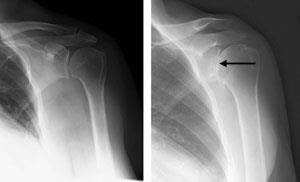
(Left) An X-ray of a healthy shoulder joint. (Right) Osteoarthritis of the shoulder. Note the decreased joint space (arrow).
Shoulder replacement surgery is highly technical. It should be performed by a surgical team with experience in this procedure.
There are different types of shoulder replacements. Your surgeon will evaluate your situation carefully before making any decisions. They will discuss with you which type of replacement will best meet your health needs. Do not hesitate to ask which type of implant will be used in your situation, and why that choice is right for you.
The standard total shoulder replacement involves replacing the arthritic joint surfaces with a highly polished metal ball attached to a stem, and a plastic socket.
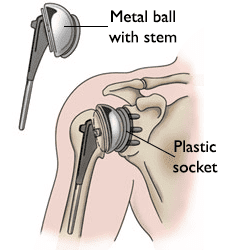
A total shoulder joint replacement.
These components come in various sizes. They may be either cemented or press fit into the bone. If the bone is of good quality, your surgeon may choose to use a non-cemented (press-fit) humeral component. If the bone is soft, the humeral component may be implanted with bone cement. In most cases, an all-plastic glenoid (socket) component is implanted with bone cement.
Implantation of a glenoid component is not advised if:
● The glenoid has good cartilage
● The glenoid bone is severely deficient
● The rotator cuff tendons are irreparably torn
Patients with bone-on-bone osteoarthritis and intact rotator cuff tendons are generally good candidates for conventional total shoulder replacement.
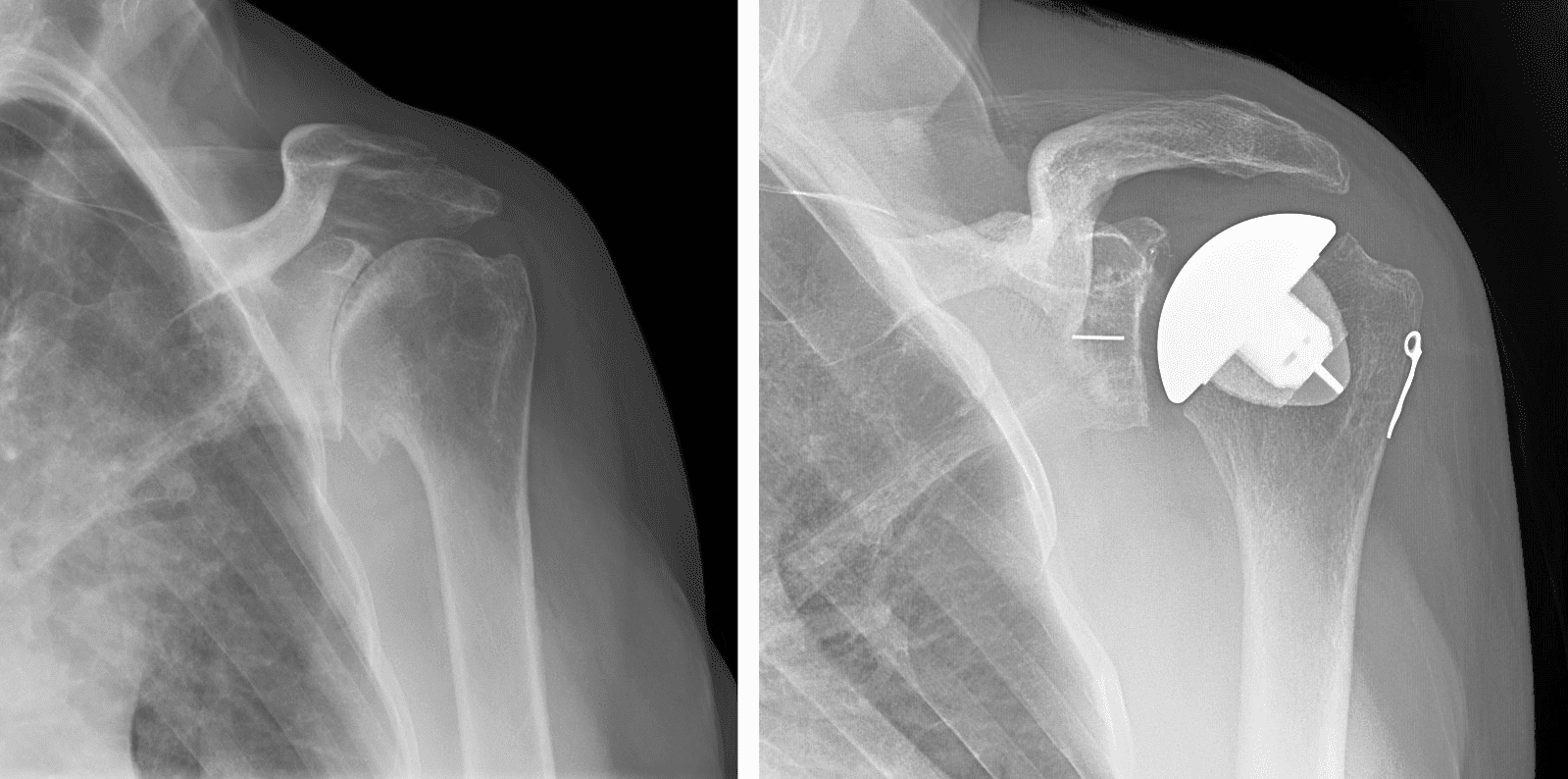
These X-rays were taken before and after total shoulder replacement surgery for osteoarthritis.
Depending on the condition of your shoulder, your surgeon may replace only the ball. This procedure is called a hemiarthroplasty. In a traditional hemiarthroplasty, the surgeon replaces the head of the humerus with a metal ball and stem, similar to the component used in a total shoulder replacement. This is called a stemmed hemiarthroplasty.
Some surgeons recommend hemiarthroplasty when the humeral head is severely fractured but the socket is normal. Other indications for a hemiarthroplasty include:
● Arthritis that involves only the head of the humerus, with a glenoid that has a healthy and intact cartilage surface
● Shoulders with severely weakened bone in the glenoid
● Some shoulders with severely torn rotator cuff tendons and arthritis
Sometimes, surgeons make the decision between a total shoulder replacement and a hemiarthroplasty in the operating room at the time of the surgery.
Studies show that patients with osteoarthritis get better pain relief from total shoulder arthroplasty than from hemiarthroplasty.
Resurfacing hemiarthroplasty involves replacing just the joint surface of the humeral head with a cap-like prosthesis without a stem. With its bone-preserving advantage, it offers those with arthritis of the shoulder an alternative to the standard stemmed shoulder replacement.
Resurfacing hemiarthroplasty may be an option for you if:
● The glenoid still has an intact cartilage surface
● There has been no fresh fracture of the humeral neck or head
● There is a desire to preserve humeral bone
For patients who are young or very active, resurfacing hemiarthroplasty avoids the risks of component wear and loosening that may occur with conventional total shoulder replacements in this patient population. Due to its more conservative nature, resurfacing hemiarthroplasty may be easier to convert to total shoulder replacement, if necessary, at a later time.
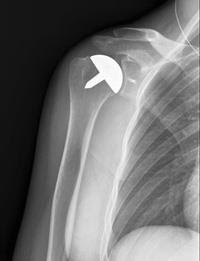
This X-ray shows the cap-like prosthesis used in resurfacing hemiarthroplasty.
Another type of shoulder replacement is called reverse total shoulder replacement. Reverse total shoulder replacement is used for people who have:
● Completely torn rotator cuffs with severe arm weakness
● The effects of severe arthritis and rotator cuff tearing (cuff tear arthropathy)
● Had a previous shoulder replacement that failed
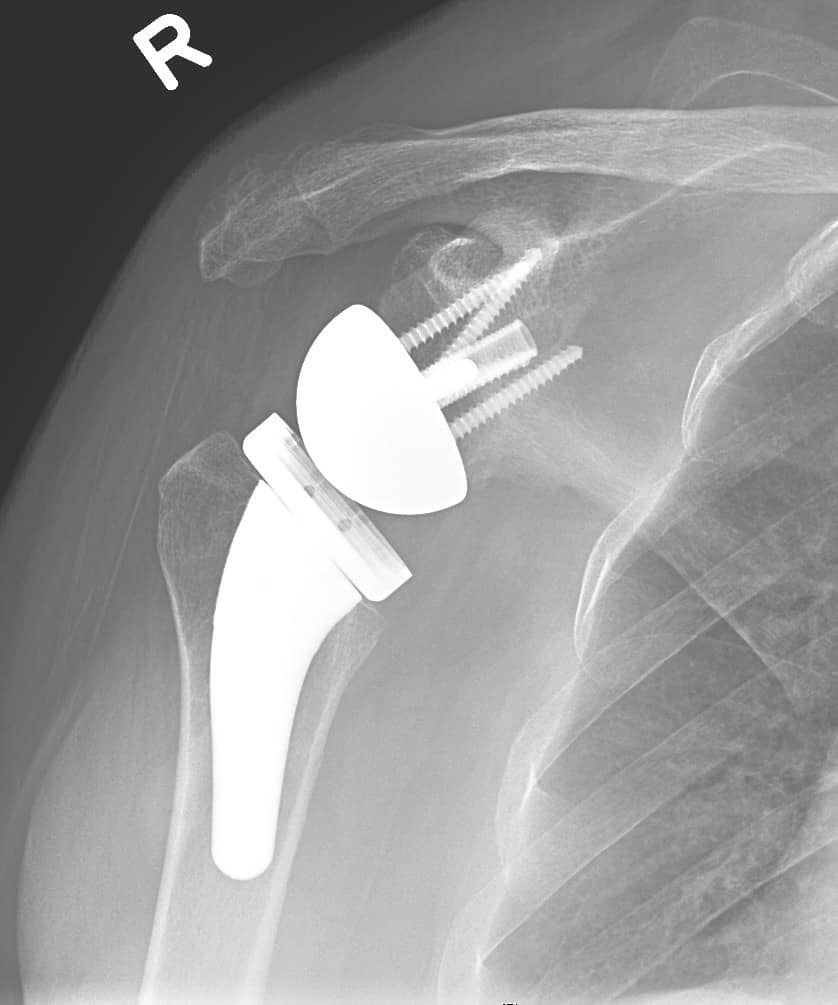
An X-ray of a reverse total shoulder replacement.
For these individuals, a conventional total shoulder replacement can still leave them with pain. They may also be unable to lift their arm up past a 90-degree angle. Not being able to lift your arm away from the side can be severely debilitating.
In reverse total shoulder replacement, the socket and metal ball are switched: A metal ball is attached to the shoulder bone, and a plastic socket is attached to the upper arm bone. This allows the patient to use the deltoid muscle instead of the torn rotator cuff to lift the arm.
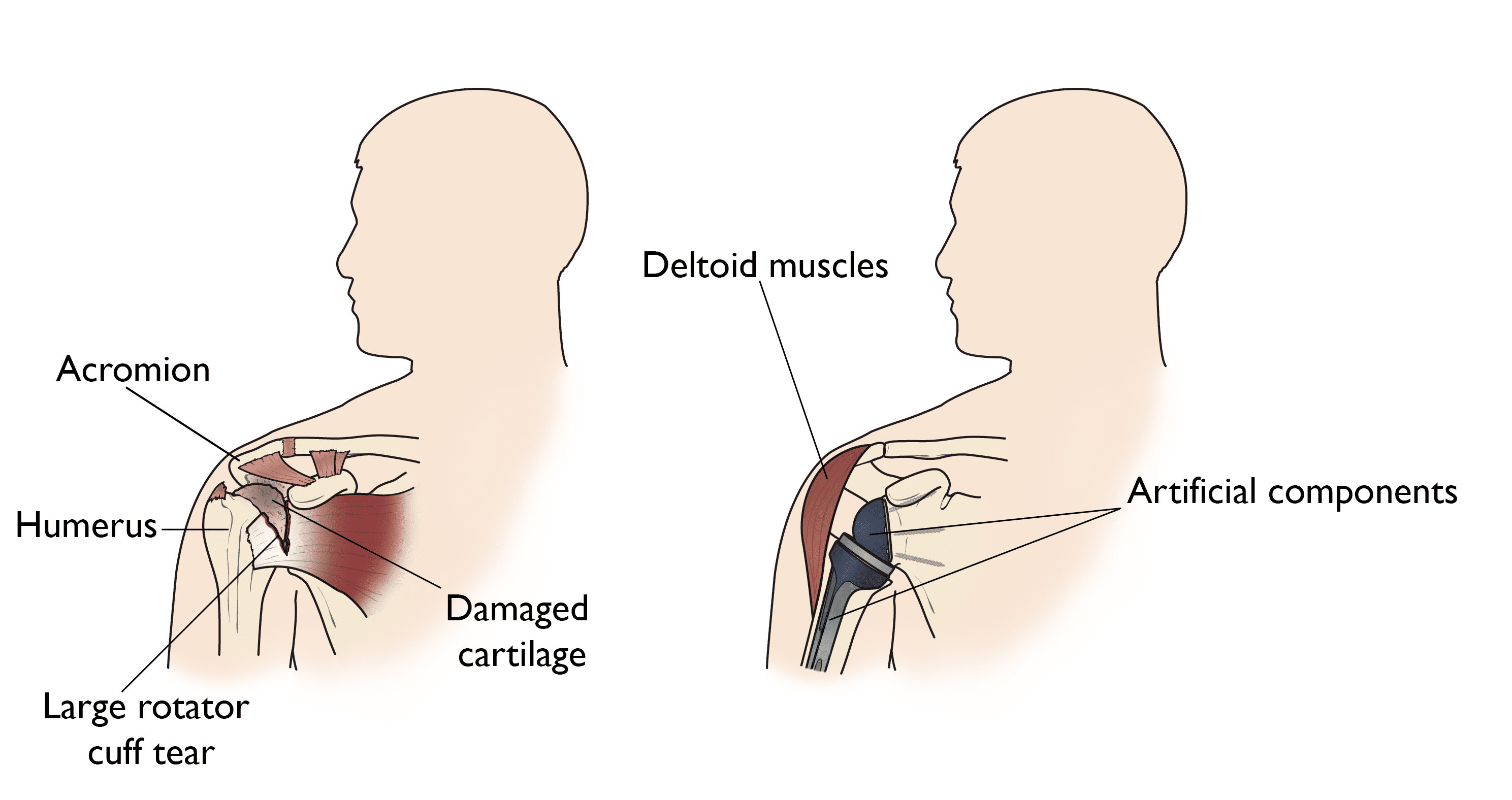
(Left) Rotator cuff arthropathy. (Right) The reverse total shoulder replacement allows other muscles — such as the deltoid — to do the work of the damaged rotator cuff tendons.
Your orthopaedic surgeon will explain the potential risks and complications of shoulder joint replacement, including those related to the surgery itself and those that can occur over time after your surgery.
When complications occur, most are successfully treatable.
Possible complications include the following.
● Infection. Infection is a complication of any surgery. In shoulder joint replacement, infection may occur in the wound or deep around the prosthesis. It may happen while in the hospital or after you go home. It may even occur years later. Minor infections in the wound area are generally treated with antibiotics. Major or deep infections may require more surgery and removal of the prosthesis. Any infection in your body can spread to your joint replacement.
● Prosthesis Problems.Although prosthesis designs and materials, as well as surgical techniques, continue to advance, the prosthesis may wear down and the components may loosen. The components of a shoulder replacement may also dislocate. Excessive wear, loosening, or dislocation may require additional surgery (revision procedure).
● Nerve damage.Nerves in the vicinity of the joint replacement may be damaged during surgery, although this type of injury is infrequent. Over time, these nerve injuries often improve and may completely recover.
If you decide to have shoulder replacement surgery, your orthopaedic surgeon may ask you to schedule a complete physical examination with your family physician several weeks before surgery. This is needed to make sure you are healthy enough to have the surgery and complete the recovery process. Many patients with chronic medical conditions, like heart disease, must also be evaluated by a specialist, such as a cardiologist, before the surgery.
Be sure to talk to your orthopaedic surgeon about the medications you take. Some medications may need to be stopped before surgery. For example, the following over-the-counter medicines may cause excessive bleeding and should be stopped 2 weeks before surgery:
● Non-steroidal anti-inflammatory drugs (NSAIDs), such as aspirin, ibuprofen, and naproxen
● Most arthritis medications
If you take blood thinners, either your primary care doctor or cardiologist will advise you about stopping these medications before surgery.
Making simple changes in your home before surgery can make your recovery period easier.
For the first several weeks after your surgery, it will be hard to reach high shelves and cupboards. Before your surgery, be sure to go through your home and place any items you may need afterwards on low shelves.
When you come home from the hospital, you will need help for a few weeks with some daily tasks like dressing, bathing, cooking, and laundry. If you will not have any support at home immediately after surgery, you may need a short stay in a rehabilitation facility until you become more independent.
Wear loose-fitting clothes and a button-front shirt when you go to the hospital for your surgery. After surgery, you will be wearing a sling and will have limited use of your arm.
You will most likely be admitted to the hospital on the day of your surgery. After admission, you will be taken to the preoperative preparation area and will meet a doctor from the anesthesia department.
You, your anesthesiologist, and your surgeon will discuss the type of anesthesia to be used. You may be provided a general anesthetic (you are asleep for the entire operation), a regional anesthetic (you may be awake but have no feeling around the surgical area), or a combination of both types.
The procedure to replace your shoulder joint with an artificial device usually takes about 2 hours.
After surgery, you will be moved to the recovery room, where you will remain for several hours while your recovery from anesthesia is monitored. After you wake up, you will be taken to your hospital room.
Your medical team will give you several doses of antibiotics to prevent infection. Most patients are able to eat solid food and get out of bed the day after surgery. You will most likely be able to go home on the first, second, or third day after surgery.
After surgery, you will feel some pain. This is a natural part of the healing process. Your doctor and nurses will work to reduce your pain, which can help you recover from surgery faster.
Medications are often prescribed for short-term pain relief after surgery. Many types of medicines are available to help manage pain, including opioids, non-steroidal anti-inflammatory drugs (NSAIDs), and local anesthetics. Your doctor may use a combination of these medications to improve pain relief, as well as minimize the need for opioids.
Be aware that although opioids help relieve pain after surgery, they are a narcotic and can be addictive. Opioid dependency and overdose have become a critical public health issues in the U.S. It is important to use opioids only as directed by your doctor and to stop taking them as soon as your pain begins to improve. Talk to your doctor if your pain has not begun to improve within a few days of your surgery.
Pain management is an important part of your recovery. You will begin physical therapy soon after surgery, and when you feel less pain, you can start moving sooner and get your strength back more quickly. Talk with your doctor if postoperative pain becomes a problem.
A careful, well-planned rehabilitation program is critical to the success of a shoulder replacement. You usually start gentle physical therapy soon after the operation. Your surgeon or physical therapist will provide you with a home exercise program to strengthen your shoulder and improve flexibility.
When you leave the hospital, your arm will be in a sling. You will need the sling to support and protect your shoulder for the first 2 to 6 weeks after surgery, depending on the complexity of your surgery and your surgeon's preference.
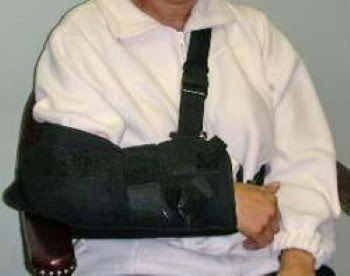
(Left) Rotator cuff arthropathy. (Right) The reverse total shoulder replacement allows other muscles — such as the deltoid — to do the work of the damaged rotator cuff tendons.
Wound care. You will have staples running along your wound or a suture beneath your skin. The staples will be removed several weeks after surgery. A dissolving suture beneath your skin will not require removal.
Avoid soaking the wound in water until it has thoroughly sealed and dried. You may continue to bandage the wound to prevent irritation from clothing.
Activity. Exercise is a critical component of home care, particularly during the first few weeks after surgery. Follow your surgeon's home exercise plan to help you regain strength. Most patients are able to perform simple activities such as eating, dressing, and grooming, within 2 weeks after surgery. Some pain with activity and at night is common for several weeks after surgery.
You are not allowed to drive a car for 2 to 6 weeks after surgery.
The success of your surgery will depend largely on how well you follow your orthopaedic surgeon's instructions at home during the first few weeks after surgery. Here are some common do's and don'ts for when you return home:
● Don't use the arm to push yourself up in bed or from a chair because this requires forceful contraction of muscles.
Do follow the program of home exercises prescribed for you. You may need to do the exercises 2 to 3 times a day for a month or more.
Don't overdo it! If your shoulder pain was severe before the surgery, the experience of pain-free motion may lull you into thinking that you can do more than is prescribed. Early overuse of the shoulder may result in severe limitations in motion.
Don't lift anything heavier than a glass of water for the first 2 to 4 weeks after surgery.
Do ask for assistance. Your physician may be able to recommend an agency or facility to help if you do not have home support.
Don't participate in contact sports or do any repetitive heavy lifting after your shoulder replacement.
Do avoid placing your arm in any extreme position, such as straight out to the side or behind your body for the first 6 weeks after surgery.
Many thousands of patients have experienced an improved quality of life after shoulder joint replacement surgery.
They experience less pain, improved motion and strength, and better function.